Charlie ‘saved’…support the Coast Guard Foundation
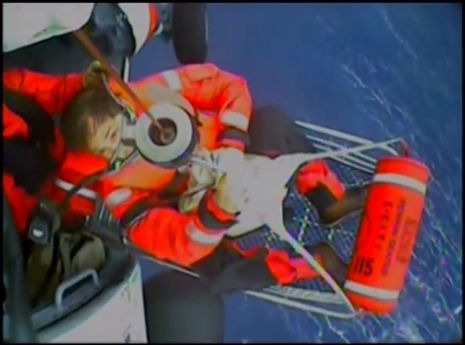 My friend and colleague, Charlie Doane, has been making the pages of Panbo since at least 2005 (sometimes even comically), and he does seem to get seriously offshore more than any other active writer I can think of. But, damn, it’s unexpected to post an image of him being hoisted aboard a U.S. Coast Guard helicopter last week. The abandonment of the very first Alpha 42 catamaran, Be Good Too, has been covered extensively elsewhere, probably in most accurate detail by Charlie himself, and discussions about the incident rage in various online forums. While I think that chewing over maritime casualties like this is a good thing — even if it does bring out the pedantic ass in some of us — let me also suggest an appropriate course of action for interested bystanders…
My friend and colleague, Charlie Doane, has been making the pages of Panbo since at least 2005 (sometimes even comically), and he does seem to get seriously offshore more than any other active writer I can think of. But, damn, it’s unexpected to post an image of him being hoisted aboard a U.S. Coast Guard helicopter last week. The abandonment of the very first Alpha 42 catamaran, Be Good Too, has been covered extensively elsewhere, probably in most accurate detail by Charlie himself, and discussions about the incident rage in various online forums. While I think that chewing over maritime casualties like this is a good thing — even if it does bring out the pedantic ass in some of us — let me also suggest an appropriate course of action for interested bystanders…
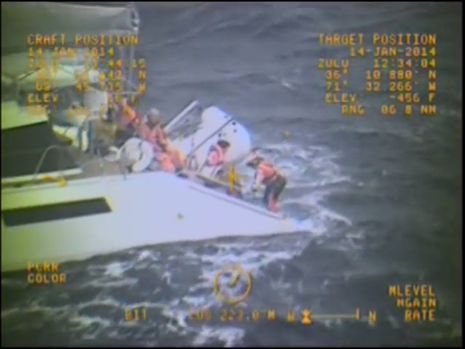 I’m already in awe of what the Coast Guard search and rescue (SAR) teams can do, but seeing a buddy in the middle of it adds another level of awesome. The screen grabs above are from the USCG video and that’s Charlie just about to jump off the stern with the encouragement of rescue swimmer John Knight. Note from their 36° 10’N, 71° 32’W position that they are about 300 lonely miles off Virginia. Besides the Jayhawk helicopter, the CG also deployed a C-130 aircraft and made helo refueling arrangements with a U.S. Navy guided missile destroyer, as described in this release.
I’m already in awe of what the Coast Guard search and rescue (SAR) teams can do, but seeing a buddy in the middle of it adds another level of awesome. The screen grabs above are from the USCG video and that’s Charlie just about to jump off the stern with the encouragement of rescue swimmer John Knight. Note from their 36° 10’N, 71° 32’W position that they are about 300 lonely miles off Virginia. Besides the Jayhawk helicopter, the CG also deployed a C-130 aircraft and made helo refueling arrangements with a U.S. Navy guided missile destroyer, as described in this release.
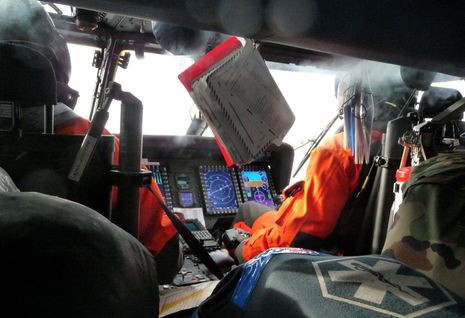 As explained in that release and also in Charlie’s account, the helo transfer wasn’t done in desperation. The folks on Be Good Too were just hoping for a ride to land from a passing AMVER ship, and the CG waited overnight before sending the Jayhawk, but surely its four-person crew were thinking of the Navy helicopter crew that crashed off Virginia just a few days before. Nonetheless, Charlie told me that they were super calm and professional, if not downright charming, and he also let me publish these photographs taken inside the helicopter.
As explained in that release and also in Charlie’s account, the helo transfer wasn’t done in desperation. The folks on Be Good Too were just hoping for a ride to land from a passing AMVER ship, and the CG waited overnight before sending the Jayhawk, but surely its four-person crew were thinking of the Navy helicopter crew that crashed off Virginia just a few days before. Nonetheless, Charlie told me that they were super calm and professional, if not downright charming, and he also let me publish these photographs taken inside the helicopter.
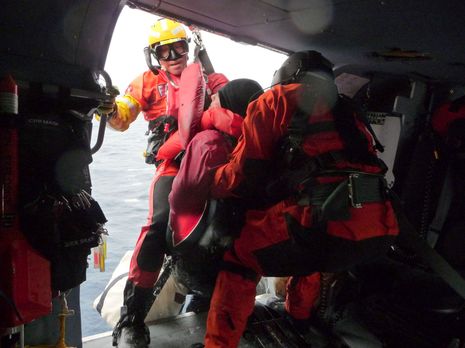 These two images of swimmer Knight and hoist operator Brian Light slinging up the catamaran’s owners — Charlie thinks himself lucky to get the basket — are particularly worth clicking on to see at greater resolution. Try to imagine the ferocious noise and vibration of the Jayhawk, along with the fact that they pulled off four boat-to-helo transitions like this. The USCG seems to have a remarkable success rate with this process, but I hope that doesn’t mask all the technology, training and courage that makes it possible.
These two images of swimmer Knight and hoist operator Brian Light slinging up the catamaran’s owners — Charlie thinks himself lucky to get the basket — are particularly worth clicking on to see at greater resolution. Try to imagine the ferocious noise and vibration of the Jayhawk, along with the fact that they pulled off four boat-to-helo transitions like this. The USCG seems to have a remarkable success rate with this process, but I hope that doesn’t mask all the technology, training and courage that makes it possible.
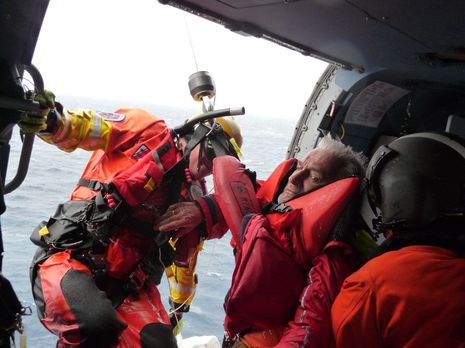 Another thing to consider is that the Coast Guard is arguably not an easy service to be part of. I’ve heard similar thoughts many times, as in the words of this writer: “A strong sense of tradition, an underdog mentality and a ‘make do with less’ attitude are the hallmarks of the U.S. Coast Guard. Unique among U.S. armed forces, the Coast Guard is perpetually on active duty, chronically underfunded, entrusted with a vast array of responsibilities, but often overlooked.”
Another thing to consider is that the Coast Guard is arguably not an easy service to be part of. I’ve heard similar thoughts many times, as in the words of this writer: “A strong sense of tradition, an underdog mentality and a ‘make do with less’ attitude are the hallmarks of the U.S. Coast Guard. Unique among U.S. armed forces, the Coast Guard is perpetually on active duty, chronically underfunded, entrusted with a vast array of responsibilities, but often overlooked.”
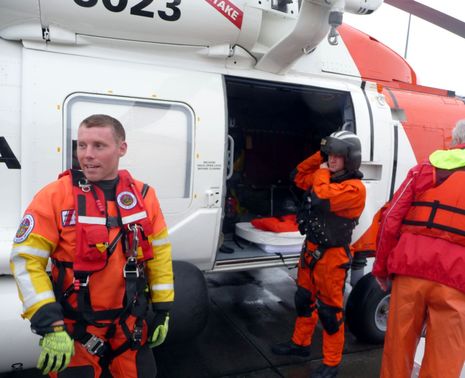 That’s why I think we should all take in the look of relief and justifiable pride on the face of AST2 John Knight — Aviation Survival Technician, 2nd class; rescue swimmer — and ask ourselves what we can do to improve the lives of the 35,000 active duty Coasties. Fortunately, there’s an excellent organization dedicated to just that task. Don’t be put off by the black tie dinners you may notice at the Coast Guard Foundation site; their good work extends throughout the chain of command (and, besides, those benefits raise a lot of money).
That’s why I think we should all take in the look of relief and justifiable pride on the face of AST2 John Knight — Aviation Survival Technician, 2nd class; rescue swimmer — and ask ourselves what we can do to improve the lives of the 35,000 active duty Coasties. Fortunately, there’s an excellent organization dedicated to just that task. Don’t be put off by the black tie dinners you may notice at the Coast Guard Foundation site; their good work extends throughout the chain of command (and, besides, those benefits raise a lot of money).
In fact the foundation makes its financial statements readily available, so you can verify that a large portion of any dollars you contribute will support sail training at the academy, recreational equipment on the cutters, relief for families in need, and many other items large and small. A few years ago I shared a meal with President Anne Brengle and was very impressed with what I heard, but it was a later incident that made me a true believer…
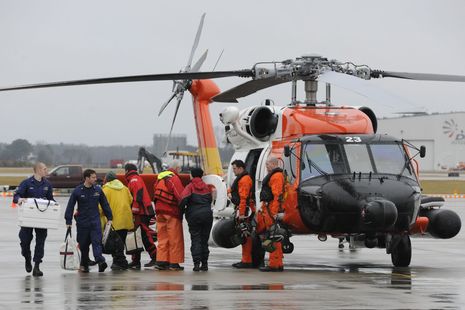 In the fall of 2012 I enjoyed the fairly famous Annapolis Boat Show evening chaos when all the sailboats exit their show so that the powerboats can get into theirs. I realized that a couple of the friendly guys keeping enthusiasts from falling off the floats were Coasties moonlighting as show security, and I asked about the foundation with no expectation that they would even know what this stranger in the dark was talking about. But one of them got quite serious and said something like “The Coast Guard Foundation helps every one of us every day in some way or other.” It couldn’t have been a stronger endorsement.
In the fall of 2012 I enjoyed the fairly famous Annapolis Boat Show evening chaos when all the sailboats exit their show so that the powerboats can get into theirs. I realized that a couple of the friendly guys keeping enthusiasts from falling off the floats were Coasties moonlighting as show security, and I asked about the foundation with no expectation that they would even know what this stranger in the dark was talking about. But one of them got quite serious and said something like “The Coast Guard Foundation helps every one of us every day in some way or other.” It couldn’t have been a stronger endorsement.
I’m closing with two photos taken by Petty Officer 3rd Class David Weydert at the Elizabeth City CG station where the crew of Be Good Too were reunited with terra firma. Charlie told me that one of the personnel there volunteered an hour ride to the airport and wouldn’t even accept gas money when they stopped to fill his truck. He also expressed appreciation and sorrow for the owners who just saw their cruising dreams shattered. I think that the image of them below could be a poster for the sort of deep relief the Coast Guard often delivers when things go badly wrong, and it might also give pause to those who jump to blame.
That said, there are interesting Sailing Anarchy and CruisersForum discussions about the incident, and I’m glad that Charlie is willing to confront the critics. (Note that both our blogs also appear in the nifty SailFeed blog garden, though potentially with different comments than what’s on our own sites). I’m going to follow the discussions myself, and I’m tentatively hoping that the Alpha 42 concept, which Charlie still thinks of as a good design, survives what may have been poor initial execution. I doubt I’ll be dissuaded from thinking of multihulls as reasonable for prudent bluewater cruising, either, though I will listen to the arguments against.
Today, though, I also donated more money to the Coast Guard Foundation and I hope you will too, even if you don’t care that Charlie Doane lives to sail another day (I kid, I kid). After all, it might be your ass in a sling eventually! (Honest, I never realized how appropriate that saying is until just now.)


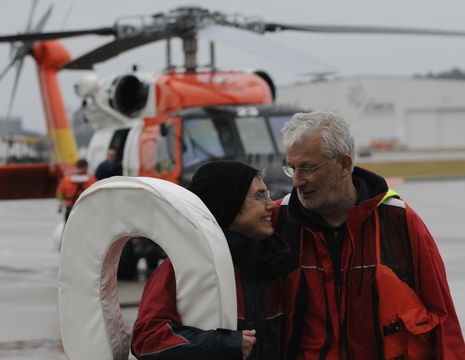











Oy, so now some Anarchy posters who claim to be multihull experts — yet lack the confidence to use their actual names on a sailing forum — are saying quite confidently they or other hotshots they know “never would have abandoned {Be Good Too} and would have gotten it to a port on their own.”
I think it’s great to discuss possible repairs at sea but it’s being done by people who weren’t there, except for Charlie who’s supplying almost all the material.
And what no one has mentioned is that this was delivery with the owners on board. I want to speak about that from my own experience. I don’t know captain Hank Schmitt at all (except that he’s extremely experienced judging from Charlie’s coverage of his work over the years). And Charlie didn’t talk with me about the owners at all yesterday, except to say how much he liked them.
So I’m talking generalities here. In my youth I did a lot of deliveries, mostly coastal, with and without owners. There’s a significant difference regardless of who the owners are. A captain is not only moving an unfamiliar boat from A to B, often in the wrong season, but he or she is also to certain degree taking passengers along. And/or the captain is also sailing with someone who actually has the power of a captain (by dint of ownership).
It’s just different, which is why some delivery skippers will never take a job with the owner on board. The lines of responsibility and decision making are simply more complicated. I had a lot of good experiences with owners — it’s fantastic to help someone really learn his or her boat — but I once also bailed on a fool I was supposed to ‘help’ from Florida to Maine. The ticket taker at the Greyhound station told me that they’d never before seen someone smiling as they bought a seat all the way from Daytona to Portland.
I digress but hopefully you get the point. Confidently second guessing Schmitt’s repair abilities is only half the oblivious foolishness out there.
Agreed. Charlie and Hank clearly have the experience to judge whether or not they could jury rig the boat to make shore. We do not know what was available etc. etc. As I noted on Charlies blog, the questions now are not about what might have, could have or should have been done. Instead, as you noted above the questions are whether the design inherently increased the probability of a catastrophic failure (your comments about catamarans in general, and my private thoughts about the distribution of bouyance) and secondly as to whether the entire vessel was designed and built as solidly as Charlie feels the hull was.
Presumably, whoever the insurance company chooses to handle this would look at the design and material selection as well as the sistership now well along to answer this. Then again, it depends on the amount of insurance involved.
…are saying quite confidently they or other hotshots they know,
“never would have abandoned {Be Good Too} and would have gotten it to a port on their own.”
These experts use their keyboards like jackhammers to get to the core of things, which is-they would never make the same mistake.
I find it refreshing when the professionals(that are confident enough to admit mistakes),talk about these mishaps- second guess the decisions they made,and offer what they would have done differently(who wouldn’t want a few re-starts?).
That’s worth something, and it takes some courage.
Your request to donate to the USCG Foundation resonated with me.
It could’ve been anyone of us in need of rescue.
Back in ’91, late fall, the infamous “Perfect Storm” slammed the NE with waves estimated to be 100′ off LI. There was a small boat with a crew of 3 requesting an airlift off LI’s south shore.
The CG helo, hovering just about the wave tops, in total darkness dropped a swimmer. He had to time his jump to catch the top of the wave. They never recovered his body. They figured he jumped into the trough. I read in the local paper he left a young family. I donated, with much sadness.
Ronbo
Congratulations to the men and women of the USCG for a job very well done! Semper Paratus … So others may live.
My son is in the Coast Guard. Thanks for being aware of how much they do, how hard they train, and how little funding they get for the job they have.
Ben, good take on Charlie’s harrowing adventure. I looked at some of the forum comments, and this type of story will always bring out the worst of the armchair critics who were not there, weren’t 300 miles offshore in poor weather, are instant diesel mechanics, electrical experts, naval architects, and own a crystal ball. Good on Charlie for responding to the critics, but all to often as I have painfully learned, it’s like trying to put out a fire with gasoline. You can’t change some minds, even with the facts.
Thanks, Bill. Off topic but I just stumbled on the excellent marine networking piece you wrote for Ocean Navigator. Well done!
http://www.oceannavigator.com/September-2013/Marine-networking/
This is what the Coast Guard does on a daily basis in a fishing town, they save lives, and boats when possible.
http://www.newslincolncounty.com/archives/104806
I know the Australian multihullers are big on parachute anchors for heaving to in nasty weather.They like to race in some amazing seas down there.
A parachute anchor would have pulled their bow to wind,stopping any drift.Would have given them a more stable platform to work from but don’t know if it would have made any difference in the long run.
I have a 12 foot dia one for my 32 ft catamaran but have not had to deploy it yet.
Thanks Ben, it was an archaeological dig.
On the subject of armchair captains: I read many stories about things such as the loss of boats at sea. I know that, because I wasn’t there, I have no right to criticize the decisions that were made. Instead, I try to learn as many details as I can, so that I can learn from other people’s experience and misfortune.
On the subject of the Coast Guard Foundation: I am a supporter of the Foundation and contribute whenever I can. But I’m not happy about that! Why? Because, like other ordinary Americans, I pay my full share of taxes every year, and yet a vital agency that actually helps people like me goes underfunded. Instead, my taxes are diverted to paying part of the wages of employees of corporations like Walmart and McDonalds so their obscenely wealthy owners don’t have to.
The work of the Coast Guard could be completely and comfortably funded for several years if Congress did not insist on building fighter planes that don’t work and that the Air Force and Navy don’t want, tanks that the Army will not accept, and “just one more” aircraft carrier after another.
I’m thinking that the rudder and control arm might have been initially damaged in the ice at the marina.
This could be the incident to prompt builders of blue water yachts to include a mechanism to drop a rudder out the bottom in an extreme situation – well designed to be fool-proof of course..
The story does not discuss the amount of flotation built into the boat – though it sounds as if there is not based on the owner’s belief it would sink.
I am a firm believer in adequate flotation in offshore vessels.
I was coming out of Norfolk, headed for Bermuda, as this was happening (I think). At least I heard a lot on the VHF about something similar. After reading comments above, I have three:
1. people who don’t make mistakes never learn anything.
2. people who don’t go offshore but know everything are not worth listening to.
3. The Coaast Guard Foundation is a good deal. I have panned the Coast Guard sometimes because some of their members don’t have enough sea time to be sensible, but as a whole they do a whole lot with almost no resources.
I do not see how anyone can second guess Capt. Charlie and owner Gunther’s decision to abandon ship. They waited and they tried and tried first for over 48 hours the deal with two separate vessel disabling issues before they made their decision. Capt. Charlie is a Professional and to Professional skippers the lives of the crew ALWAYS come first.
Had they waited longer and had their SAT phone batteries died it would have only gotten worse.
PS: God please Bless the USCG and please keep them safe.